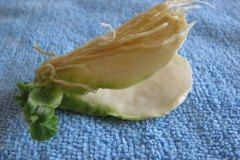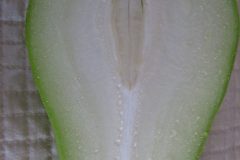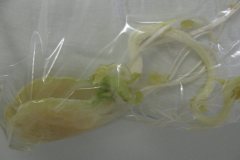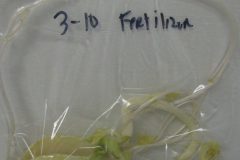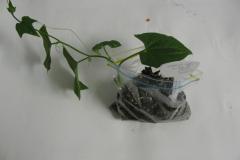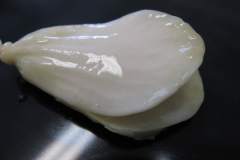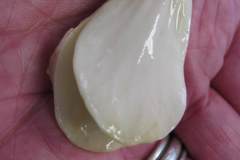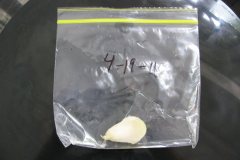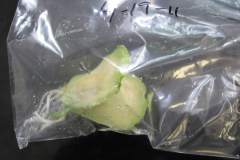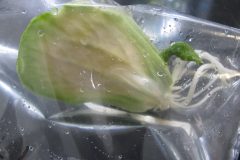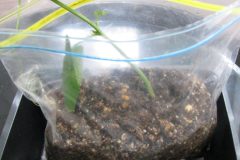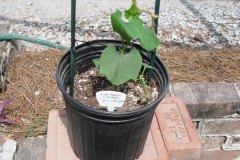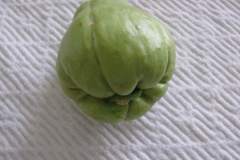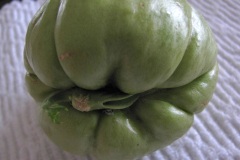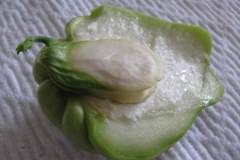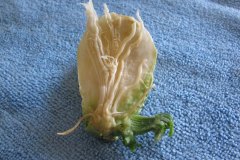 Bag-sprouted seed successfully transplanted to soil container (plastic bag with drainage holes--fed with water-soluble fertilizer. This was later transplanted to a two-gallon container. Be careful when transplanting sprout to completely cover it with soil and keep in indirect light until the shoot emerges. Then gradually introduce into full sun--otherwise you will UV burn the sprout.
Bag-sprouted seed successfully transplanted to soil container (plastic bag with drainage holes--fed with water-soluble fertilizer. This was later transplanted to a two-gallon container. Be careful when transplanting sprout to completely cover it with soil and keep in indirect light until the shoot emerges. Then gradually introduce into full sun--otherwise you will UV burn the sprout.
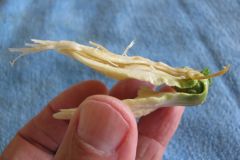 I have discovered that mirliton seeds can survive outside the fruit for at least three weeks if kept in a plastic bag with a few ounces of water. The seed (embryo) is best removed when it begins to emerge as a sprout from the wide end of the fruit. Cut the fruit carefully so as not to damage the seed and split open the fruit and remove the seed. Place the seed in a plastic bag with water and store in a cool place out of direct sun (can be kept in dark). The seed will send out roots and a sprout but after about three weeks it will begin to deteriorate. I have been successful in transplanting the bag-sprouted seed into a small container with soil and later transplanting into a two-gallon container and the plant thrived. This is an ideal way to mail heirloom seeds since it reduces mailing costs and ensures that the seed has already sprouted. It is also a good method of saving the soft seed if the outer fruit wall gets a fungus that destroys the seeds only source of water and nutrients during germination
I have discovered that mirliton seeds can survive outside the fruit for at least three weeks if kept in a plastic bag with a few ounces of water. The seed (embryo) is best removed when it begins to emerge as a sprout from the wide end of the fruit. Cut the fruit carefully so as not to damage the seed and split open the fruit and remove the seed. Place the seed in a plastic bag with water and store in a cool place out of direct sun (can be kept in dark). The seed will send out roots and a sprout but after about three weeks it will begin to deteriorate. I have been successful in transplanting the bag-sprouted seed into a small container with soil and later transplanting into a two-gallon container and the plant thrived. This is an ideal way to mail heirloom seeds since it reduces mailing costs and ensures that the seed has already sprouted. It is also a good method of saving the soft seed if the outer fruit wall gets a fungus that destroys the seeds only source of water and nutrients during germination
 Botanically speaking, the entire fruit is the seed because there is no clear dividing line discernible between carpellary and extra-carpellary tissue. The fruit is the matured ovary which is a derivative of the gynoecium and whatever extra-carpellary parts it may be united with in the fruiting stage. The following pictured soft "seed" or embryo contains the hypocotyl (produces the shoot); the radicle (produces roots); and the two cotyledons (white ovoid-shaped) which do not emerge from the fruit but appear to serve as storage for nutrients, water, and hormones for developing the shoot and root structure. The seed is covered by a tegument (seed coat) and then enclosed in an outlying pericarp fruit wall which is comprised of the endocarp, mesocarp, and exocarp (epicarp).
Botanically speaking, the entire fruit is the seed because there is no clear dividing line discernible between carpellary and extra-carpellary tissue. The fruit is the matured ovary which is a derivative of the gynoecium and whatever extra-carpellary parts it may be united with in the fruiting stage. The following pictured soft "seed" or embryo contains the hypocotyl (produces the shoot); the radicle (produces roots); and the two cotyledons (white ovoid-shaped) which do not emerge from the fruit but appear to serve as storage for nutrients, water, and hormones for developing the shoot and root structure. The seed is covered by a tegument (seed coat) and then enclosed in an outlying pericarp fruit wall which is comprised of the endocarp, mesocarp, and exocarp (epicarp).
 Seed sprouted in plastic bag. This was 17 days after transplanting from fruit to the bag. In this test, I used liquid fertilizer in place of water, but there was little difference. The seed absorbs oxygen to the extent that I had to open the bag to allow more air in (created a vacuum effect). Note that the roots and shoot developed in the bag--this was kept in the dark so all plant parts are mostly white. Seeds exposed to light developed at the same rate but were green
Seed sprouted in plastic bag. This was 17 days after transplanting from fruit to the bag. In this test, I used liquid fertilizer in place of water, but there was little difference. The seed absorbs oxygen to the extent that I had to open the bag to allow more air in (created a vacuum effect). Note that the roots and shoot developed in the bag--this was kept in the dark so all plant parts are mostly white. Seeds exposed to light developed at the same rate but were green
